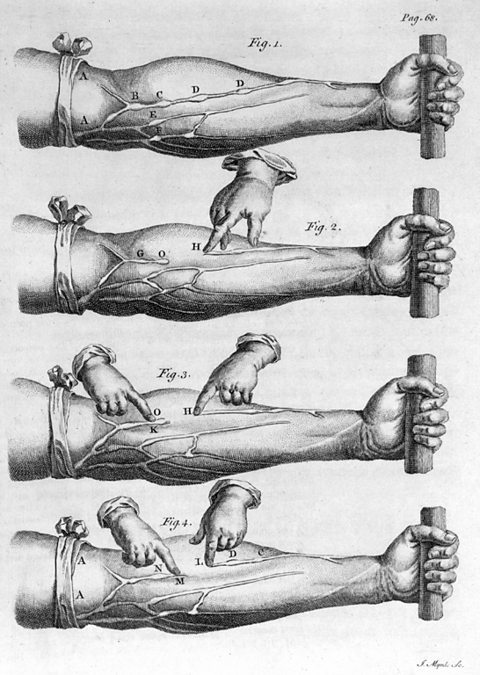Case study - William Harvey
William Harvey studied medicine at the University of Cambridge and at a famous medical school in Padua, Italy, during the Renaissance. Like Andreas Vesalius, Harvey was interested in anatomyThe science dealing with the structure of animals and plants. He became a lecturer in anatomy and was a doctor to Charles I.
Discovery of the circulation of the blood

Harvey was very interested in how blood flowed around the body. Galen had taught that blood was made in the liver and then pumped around the body. However, Harvey proved that GalenÔÇÖs ideas were wrong.
Harvey proved VesaliusÔÇÖ theory that the veins of the body contained valve A device that allows movement in one direction. These valves enabled blood to flow through the veins towards the heart in one direction. Harvey tried to pump other liquids through the veins in the other direction, but this did not work.
Harvey carried out a series of scientific experiments including:
- dissectionThe action of cutting apart the body of an animal or plant to examine its internal structure. human corpseA dead body. and carefully observing the heart
- dissecting cold-blooded animals, such as frogs, because they had a slower heartbeat and this enabled the movement of blood to be observed
- measuring blood flow to show that the same blood is pumped around the body repeatedly by the heart
In 1628, Harvey published his discovery in a book called An Anatomical Account of the Motion of the Heart and Blood. This enabled doctors to learn from his discovery.
The role of technology - the microscope
It is believed that mechanical Operated by machinery. water pumps used by firefighters in the 17th century may have given Harvey the idea that blood is pumped around the body by the heart. These pumps had valves to help direct the flow of water.
However, Harvey was unable to explain everything about the circulation of the blood. He was unable to explain how blood moves from the arteries to the veins. Harvey believed tiny passages carried the blood but that they were invisible to the naked eye.
Soon after his death, this was proven by Marcello Malpighi, who used one of the first effective microscopeA scientific instrument that uses a magnifying lens to allow observation of objects too small to be viewed by the naked eye. He discovered tiny blood vessels that carry blood from the arteries to the veins. We call these vessels capillaries Tiny blood vessels linking arteries to veins. Microscopes were a key technological development in the Renaissance that transformed medical knowledge.